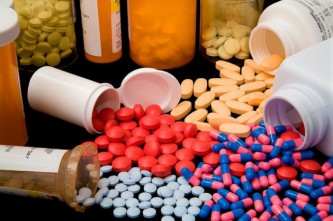Antibiotics? Handle with Care
TRANSCEND MEMBERS, 15 Nov 2021
Baher Kamal | Human Wrongs Watch - TRANSCEND Media Service
11 Nov 2021 – Antibiotics, like other antimicrobials, have become a threat to health rather than healing it. Why? Because their misuse and overuse have created such a strong resistance that they no longer respond to medicines, making infections harder to treat and increasing the risk of disease spread, severe illness and death.

The main drivers of antimicrobial resistance include the misuse and overuse of antimicrobials; lack of access to clean water, sanitation and hygiene for both humans and animals; poor infection and disease prevention and control in health-care facilities and farms; poor access to quality, affordable medicines, vaccines and diagnostics; lack of awareness and knowledge; and lack of enforcement of legislation. Credit: Bigstock.
Much so that antimicrobial resistance is now considered among the top 10 global public threats facing humanity.
In fact, an estimated 700 000 people die each year from antimicrobial resistant (AMR) infections, in addition to an untold number of sick animals that may not be responding to treatment.
In short, antimicrobial resistance is a significant global threat to public health, food safety and security, as well as to livelihoods, animal production and economic and agricultural development.
What happens?
According to the World Health Organization (WHO) The misuse and overuse of antibiotics in livestock is meant to prevent contagion from one animal to the rest of the herd, thus increasing milk and meat production, in pursuit of more profits.
A similar case is the misuse and overuse of different antimicrobials in agriculture with the aim of obtaining more production and therefore more commercial benefits.
The point is that human consumption of meat and vegetables and fruits also imply their ingestion of antimicrobials in the daily diet.
What are antimicrobials?
The following information is based on investigations and studies carried out by the World Health Organisation (WHO) and the Food and Agriculture Organisation (FAO).
Antimicrobials – including antibiotics, antivirals, antifungals and antiparasitics – are medicines used to prevent and treat infections in humans, animals and plants.
What is antimicrobial resistance?
Antimicrobial Resistance occurs when bacteria, viruses, fungi and parasites change over time and no longer respond to medicines making infections harder to treat and increasing the risk of disease spread, severe illness and death.
As a result of drug resistance, antibiotics and other antimicrobial medicines become ineffective and infections become increasingly difficult or impossible to treat.
Why is it a global concern?
The emergence and spread of drug-resistant pathogens that have acquired new resistance mechanisms, leading to antimicrobial resistance, continues to threaten our ability to treat common infections.
Especially alarming is the rapid global spread of multi- and pan-resistant bacteria (also known as “superbugs”) that cause infections that are not treatable with existing antimicrobial medicines such as antibiotics.
Furthermore, a lack of access to quality antimicrobials remains a major issue. Antibiotic shortages are affecting countries of all levels of development and especially in health-care systems.
Change or loose
In other words, new antibacterials are urgently needed – for example, to treat carbapenem-resistant gram-negative bacterial infections as identified in the WHO priority pathogen list.
However, if people do not change the way antibiotics are used now, new antibiotics will suffer the same fate as the current ones and become ineffective.
Without effective tools for the prevention and adequate treatment of drug-resistant infections and improved access to existing and new quality-assured antimicrobials, the number of people for whom treatment is failing or who die of infections will increase.
Medical procedures, such as surgery, including caesarean sections or hip replacements, cancer chemotherapy, and organ transplantation, will become more risky.
What accelerates the emergence and spread of antimicrobial resistance?
AMR occurs naturally over time, usually through genetic changes. Antimicrobial resistant organisms are found in people, animals, food, plants and the environment (in water, soil and air).
They can spread from person to person or between people and animals, including from food of animal origin.
The main drivers of antimicrobial resistance include the misuse and overuse of antimicrobials; lack of access to clean water, sanitation and hygiene for both humans and animals; poor infection and disease prevention and control in health-care facilities and farms; poor access to quality, affordable medicines, vaccines and diagnostics; lack of awareness and knowledge; and lack of enforcement of legislation.
Present situation
For common bacterial infections, including urinary tract infections, sepsis, sexually transmitted infections, and some forms of diarrhoea, high rates of resistance against antibiotics frequently used to treat these infections have been observed world-wide, indicating that we are running out of effective antibiotics.
Drug resistance in malaria parasites
Another example is the case of the emergence of drug-resistant parasites which poses one of the greatest threats to malaria control and results in increased malaria morbidity and mortality.
Drug resistance in fungi
The prevalence of drug-resistant fungal infections is exasperating the already difficult treatment situation. Many fungal infections have existing treatability issues such as toxicity especially for patients with other underlying infections (e.g. HIV).
This is leading to more difficult to treat fungal infections, treatment failures, longer hospital stays and much more expensive treatment options.
A week to raise awareness
This year’s World Antimicrobial Awareness Week (WAAW) marked 18 to 24 November was previously called the World Antibiotic Awareness Week.
But from 2020, it would be called the World Antimicrobial Awareness Week to include all antimicrobials including antibiotics, antifungals, antiparasitics and antivirals.
The Week is a global campaign that aims to raise awareness of antimicrobial resistance worldwide and encourage best practices among the general public, health workers and policy makers to slow the development and spread of drug-resistant infections.
Is obtaining more and more commercial benefits a reason enough to transform the healers into killers?
_____________________________________________
 Baher Kamal, a member of the TRANSCEND Network for Peace Development Environment, is an Egyptian-born, Spanish national, secular journalist, with over 45 years of professional experience — from reporter to special envoy to chief editor of national dailies and an international news agency. Baher is former Senior Advisor to the Director General of the international news agency IPS (Inter Press Service) and he also contributed to prestigious magazines such as TRANSCEND Media Service, GEO, Muy Interesante, and Natura, Spain. He is also publisher and editor of Human Wrongs Watch.
Baher Kamal, a member of the TRANSCEND Network for Peace Development Environment, is an Egyptian-born, Spanish national, secular journalist, with over 45 years of professional experience — from reporter to special envoy to chief editor of national dailies and an international news agency. Baher is former Senior Advisor to the Director General of the international news agency IPS (Inter Press Service) and he also contributed to prestigious magazines such as TRANSCEND Media Service, GEO, Muy Interesante, and Natura, Spain. He is also publisher and editor of Human Wrongs Watch.
Go to Original – human-wrongs-watch.net
Tags: Antibiotics, Big Pharma, Probiotics, Science and Medicine
DISCLAIMER: The statements, views and opinions expressed in pieces republished here are solely those of the authors and do not necessarily represent those of TMS. In accordance with title 17 U.S.C. section 107, this material is distributed without profit to those who have expressed a prior interest in receiving the included information for research and educational purposes. TMS has no affiliation whatsoever with the originator of this article nor is TMS endorsed or sponsored by the originator. “GO TO ORIGINAL” links are provided as a convenience to our readers and allow for verification of authenticity. However, as originating pages are often updated by their originating host sites, the versions posted may not match the versions our readers view when clicking the “GO TO ORIGINAL” links. This site contains copyrighted material the use of which has not always been specifically authorized by the copyright owner. We are making such material available in our efforts to advance understanding of environmental, political, human rights, economic, democracy, scientific, and social justice issues, etc. We believe this constitutes a ‘fair use’ of any such copyrighted material as provided for in section 107 of the US Copyright Law. In accordance with Title 17 U.S.C. Section 107, the material on this site is distributed without profit to those who have expressed a prior interest in receiving the included information for research and educational purposes. For more information go to: http://www.law.cornell.edu/uscode/17/107.shtml. If you wish to use copyrighted material from this site for purposes of your own that go beyond ‘fair use’, you must obtain permission from the copyright owner.